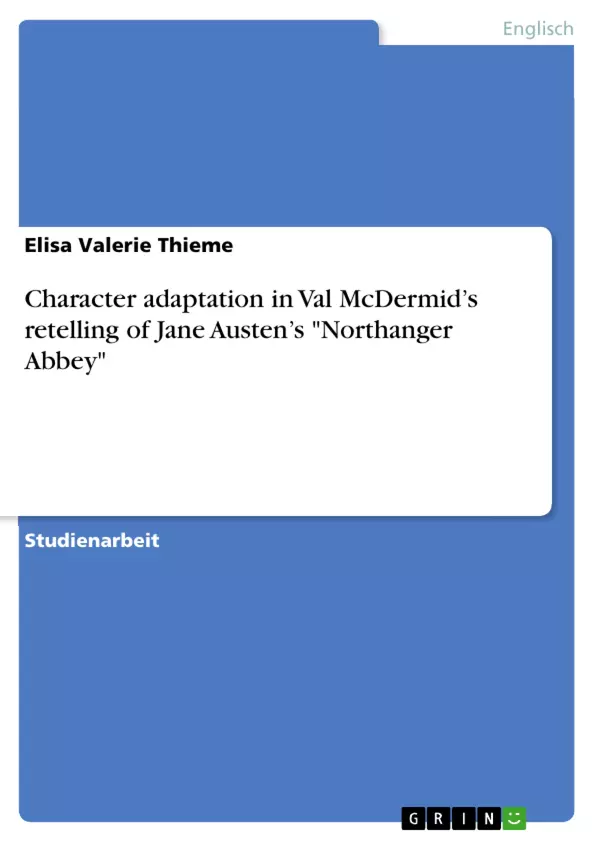Ever since their publication between the years of 1811 and 1817, Jane Austen’s novels, namely Northanger Abbey, Sense and Sensibility, Pride and Prejudice, Emma, Mansfield Park and Persuasion, have never gone out of print. Her works are “perennial favourites” (Carson xi) and, furthermore, there seems to be a huge demand for “Austen novelties”. It does not come as a surprise, therefore, that there are hundreds and hundreds of Austen adaptations and spin-offs. All six novels have been repeatedly turned into movies and the amount of literary adaptations appears to be almost uncountable. Since most “educated people . . . have at least heard of Jane Austen [and her] novels are in the public domain” (Parrill 176), adapting them seems to be particularly attractive in regard to the low economic risk and reduced investment costs (no acquisition of legal licences and little marketing costs). Austen has become a “cultural commodity[,] almost a brand name” (Wiltshire 7) and there will probably always be new publications as long as there is such a keen and vast market. The recent “Austen Project”, published by Harper Collins, sees six bestselling authors adapting Jane Austen’s novels and transposing them into the twenty-first century. Economically, it profits not only from Austen’s fan base but also from the faithful readers of popular writers such as Val McDermid, who adapted Jane Austen’s Northanger Abbey. This retelling is the latest publication of the Austen Project and seems particularly interesting since Northanger Abbey is chiefly concerned with the mocking of Gothic fiction and the vindication of reading. It deals with bestsellers from the early nineteenth century and thus appears to be firmly rooted in its time. Due to these intriguing particularities, the paper at hand is based on Val McDermid’s modern retelling of Northanger Abbey.
McDermid follows the plot structure very closely and the reinterpretation of the source text chiefly lies in the temporal, linguistic and cultural update. The plot is set in an envi-ronment shifted by two hundred years, Bath has been swapped for the now more fashiona-ble Edinburgh Festival Fringe and almost all characters are expertly tweeting, texting, and posting “selfies” on Facebook. Whereas Austen set out to write an amusing burlesque and a vindication of novel reading, McDermid’s adaptation aims at pleasing the Austen-familiar readers and at humouring them by applying a “modern twist”.
Inhaltsverzeichnis
- Introduction
- A Brief Note on Reading Women in the Early Nineteenth Century and Exchanging Gothic Fiction with Twilight
- Adaptation of Character
- Leading Ladies: Catherine "Cat" Morland, Isabella "Bella" Thorpe and Eleanor "Ellie" Tilney
- The Gents: Henry Tilney (Henry), John "Johnny" Thorpe and General "the General" Tilney
- Media Use
- Conclusion
Zielsetzung und Themenschwerpunkte
Der vorliegende Text befasst sich mit der modernen Adaption von Jane Austens Roman Northanger Abbey durch Val McDermid. Das Hauptanliegen der Analyse liegt in der Untersuchung der Charakteradaption und deren Auswirkungen auf die Dynamik der Handlung und die zwischenmenschlichen Beziehungen der Figuren. Darüber hinaus werden die Veränderungen im kulturellen Kontext, die durch die Aktualisierung des Romans auf die Gegenwart entstehen, beleuchtet.
- Die Aktualisierung des Romans auf die Gegenwart und ihre Auswirkungen auf die Handlung.
- Die Adaption der Figuren und ihre Veränderungen im Vergleich zum Original.
- Die Rolle der neuen Medien im Roman.
- Der Einfluss der Gothic-Literatur und die Verwendung des Twilight-Phänomens als moderne Entsprechung.
- Die Verbindung von Literatur und sozialer Realität in Northanger Abbey und McDermids Adaption.
Zusammenfassung der Kapitel
Der Text beginnt mit einer Einleitung, die die Relevanz von Jane Austens Romanen und der Adaption von Northanger Abbey durch Val McDermid beleuchtet. Anschließend wird die Bedeutung des Lesens für Frauen im frühen 19. Jahrhundert und die spezifische Rolle der Gothic-Literatur in diesem Kontext betrachtet. Im nächsten Abschnitt wird die Adaption der Figuren, insbesondere der weiblichen Hauptfiguren Catherine "Cat" Morland, Isabella "Bella" Thorpe und Eleanor "Ellie" Tilney, analysiert. Abschließend wird der Einfluss neuer Medien im Roman und die Aktualisierung des Gothic-Motivs durch das Twilight-Phänomen behandelt.
Schlüsselwörter
Die wichtigsten Schlüsselwörter des Textes sind: Jane Austen, Northanger Abbey, Val McDermid, Gothic-Literatur, Twilight-Phänomen, Adaption, Charakteradaption, Kulturelle Aktualisierung, Lesekultur, Frauen im 19. Jahrhundert, Medien, Social Media.
- Quote paper
- B.A. Elisa Valerie Thieme (Author), 2014, Character adaptation in Val McDermid’s retelling of Jane Austen’s "Northanger Abbey", Munich, GRIN Verlag, https://www.grin.com/document/283217



